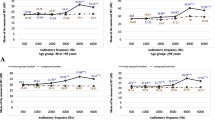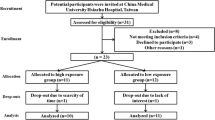Abstract
Hearing loss is one of the most common chronic health conditions and has important implications for the patient’s quality of life. However, hearing loss is substantially underestimated and under treated. The purpose of this study was to determine the prevalence of sensorineural hearing loss among the workers in a steel rolling mill in Nigeria. Each of the 150 randomly selected subjects had a structured questionnaire administered to them, followed by a full otological examination. Of these, 116 had tympanometry and pure-tone audiometry. Also a noise mapping of their respective work units was done. The workers were exposed to noise levels varying from 49 to 93 dBA. About 28.2% of the 103 who had their audiogram analysed had mild to moderate sensorineural hearing loss in their better ear and 56.8% of them had mild to moderate sensorineural hearing loss in their worse ear. The pure-tone average and the average hearing thresholds at 4 kHz for the groups significantly increased with an increasing noise exposure level. The prevalence of sensorineural hearing loss among the study population is high; and noise exposure is at least contributory. Pre-employment and regular audiometry while on the job is highly recommended.
Similar content being viewed by others
References
Borchgrevink H (2003) Does health promotion work in relation to noise? Noise Health 5(18):25–30
Palmer KT, Griffin MJ, Syddall HE, Davis A, Pannett B, Coggon D (2002) Occupational exposure to noise and the attributable burden of hearing impairment in Great Britain. Occup Environ Med 59(9):634–639
Hallberg LR (1996) Occupational hearing loss: coping and family life. Scand Audiol Suppl 43:25–33
Smith AW (1998) The World Health Organisation and the prevention of deafness and hearing impairment caused by noise. Noise Health 1(1):6–12
Brink LL, Talbott EO, Burks JA, Palmer CV (2002) changes over time in audiometric thresholds assembly workers with a hearing conservation program. AIHA J 63(4):482–487
World Health Organisation (1997) Prevention of noise induced hearing loss. Report of a WHO-PDH informal consultation, Geneva, 28–30 Oct 1997. No 3 in the series “Strategies for prevention of deafness and hearing impairment”; WHO|PDH|98.5
Akande TM, Ologe FE (2003) Noise induced hearing loss (NIHL) in the middle belt of Nigeria. Postgraduate Doctor Africa 25(4):81–82
O’connor AF (1997) Examination of the ear In: Kerr AG, Booth JB (eds) Scott Brown’s otolaryngology: otology 6th edn. Butterworth/Heineman, Oxford, pp 3/1/1–3/1/29
Wong TW, Yu TS, Chen WQ, Chiu YL, Wong CN, Wong AH (2003) Agreement between hearing thresholds measured in non-soundproof work environments and a sound proof booth. Occup Environ Med 60(9):667–671
Ahmed HO, Dennis JH, Badran O, Ismaikl M, Ballah SG, Ashoora, Jerwood D (2001) Occupational noise exposure and hearing loss of workers in two plants in Eastern Saudi Arabia. Ann Occup Hyg 45(5):371–380
Nguyen AL, Nguyen TC, Van TL, Hoang MH, Nguyen S, Jonai H, Villanneva MB, Matsuda S, Sotoyama M, Sudo A (1998) Noise levels and hearing ability of female workers in a textile factory in Vietnam. Ind Health 36(1):61–65
Tanaka M, Shimai S, Nakamura K, Takahashi H, Tanaka K (1992) Investigation of noise in a factory. Ann Physiol Anthropol 11(1):21–27
Campbell K (1998) Basic audiologic assessment. In: Dauhaeur J (eds) Essential audiology for physicians. 1st edn. Singular Publishing Ltd, London, pp 1–11
Davis RR, Kozel P, ERway LC (2003) Genetic influences in individual susceptibility to noise: a review. Noise Health 5(20):19–28
Lutman ME (2000) What is the risk of noise-induced hearing loss at 80, 85, 90 dB(A) and above? Occup Med (Lond) 50(4):274–275
Osibogun A, Igweze JA, Adeniran LO (2000) Noise-induced hearing loss among textile workers in Lagos metropolis. Niger Postgrad Med J 7(3):104–111
Shakhatreh FM, Abdul-Baqi KJ, Turk MM (2000) Hearing loss in a textile factory. Saudi Med J 21(1):58–60
Ahias J, Bresloff I (1996) Noise induced temporary otoacontic emission shifts. J Basic Clin Physiol Pharmacol 7(3):221–233
Marshall L, Lapsley Miller JA, Heller LM (2001) Distortion–product otoaconstic emissions as a screening tool for noise induced hearing loss. Noise Health 3(12):43–60
Sliwinska-Kowalska M, Kotylo P (1997) Otoacoutic emission useful in the differential diagnosis of occupational noise-induced hearing loss? Med Pr 48(6):613–620
Zhang Y, Zhang X, Zhu W, Zheng X, Deng X (2004) Distortion product of otoacoustic emissions as a sensitive indicator of hearing loss in pilots. Aviat Space Environ Med 75(1):46–48
Oleru UG (1980) Comparison of the hearing levels of Nigerian textile workers and a control group. Am Ind Hyg Assoc J 41(4):283–287
Oleru UG, Ijaduola GT, Sowho EE (1990) Hearing thresholds in an autoassembly plant: prospects for hearing conservation in a Nigerian factory. Int Arch Occup Environ Health 62(3):199–202
Palmer KT, Griffin MJ, Syddall HE, Davis A, Coggon D (2004) Cigarrette smoking, occupational exposure to noise and self reported hearing difficulties. Occup Environ Med 61(4):340–344
Author information
Authors and Affiliations
Corresponding author
Rights and permissions
About this article
Cite this article
Ologe, F.E., Akande, T.M. & Olajide, T.G. Occupational noise exposure and sensorineural hearing loss among workers of a steel rolling mill. Eur Arch Otorhinolaryngol 263, 618–621 (2006). https://doi.org/10.1007/s00405-006-0043-9
Received:
Accepted:
Published:
Issue Date:
DOI: https://doi.org/10.1007/s00405-006-0043-9




